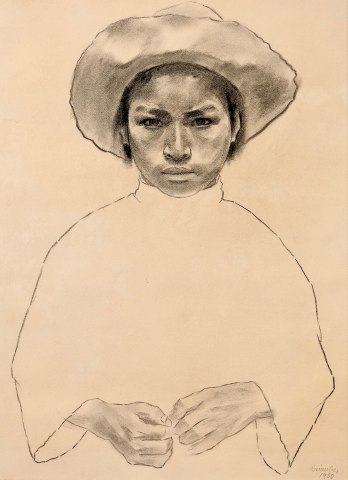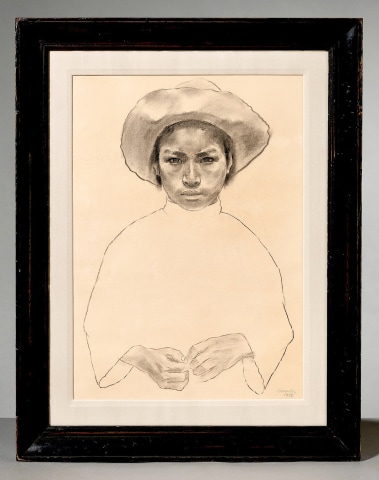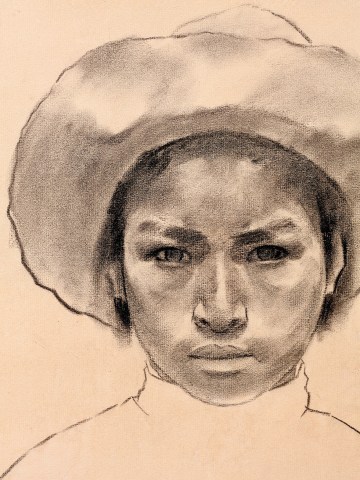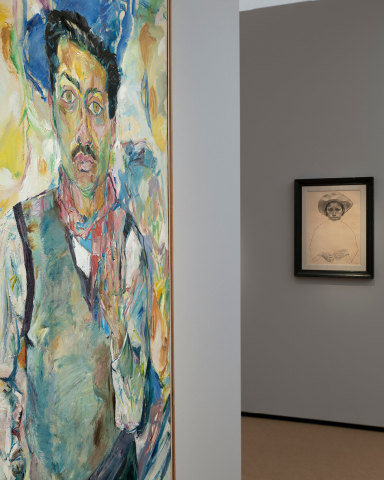Franz Anton Griessler (Austrian, 1897-1974)
Indio Boy, 1950
Charcoal on paper
Signed and dated 'Griessler/1950' lower right
Signed and dated 'Griessler/1950' lower right
61 x 43.2 cm
26P C
Further images
This explosive and vivid portrait depicts a young South American boy, the face and hands rendered with great detail whilst the body uniting the two has been left unfinished suggested...
This explosive and vivid portrait depicts a young South American boy, the face and hands rendered with great detail whilst the body uniting the two has been left unfinished suggested only by a single line, creating an unusual and striking image. He stares directly out with a fixed gaze, fidgeting with his hands, whilst a wide brim straw Sombrero shades his face from the sun.
Griessler executed several studies of this young boy and his baby brother. This portrait, titled "Indio Boy," and a sheet depicting him with his young brother strapped to his back, titled "Coya-Indio Boys," published in the Honolulu Star Bulletin, suggests that these impoverished looking immigrants to America were from the Andes and specifically the Coya tribe.
Franz Anton Griessler's artistic journey was marked by a rigorous pursuit of realism and a desire to excel in the European tradition of draughtsmanship. Born in Vienna, he commenced his artistic education at the Grafische Lehr und Versuchsanstalt in Vienna and continued his studies at the Vienna Academy of Art from 1911 to 1915. During his time at the academy, Griessler's commitment to his craft was remarkable, with daily studies spanning ten hours, encompassing anatomy, portrait painting, materials, techniques, and art history. It also including studying the Northern European Old Masters such as Albrecht Dürer, whom he greatly admired (whose work he was familiar with from the Albertina collections), as well as that of more modern draughtsmen, such as Egon Schiele, and the New Objectivity movement artists of 1920s Germany such as Grosz.
Like many artists of his generation, the course of Griessler's artistic development was interrupted by the outbreak of World War I, during which he served in the army. In 1919, he resumed his studies at the Vienna Academy, where his talent and dedication led him to become the art director of the Vienna city advertising agency, playing a vital role in re-establishing Vienna as a cultural and commercial artistic hub.
After the conclusion of World War II, Griessler left Austria and found his new home in Hawaii. Becoming an integral part of the local art scene and exhibiting nationally and internationally, Griessler's artistic focus shifted to charcoal, a medium he mastered. His portraits, often depicting the indigenous peoples of America and the Hawaiian Islands, as well as the influx of immigrants into the American workforce, demonstrated his profound skill. As an émigré, Griessler’s art perfectly captures the diversity of a modern, post-war America.
Jean Charlot, writing in the Honolulu Star Bulletin, noted: “An observer of Griessler’s art cannot but help being impressed with the directness and sureness of his renderings. His manipulation of charcoal is exceptional. Griessler’s hundreds of hours of academy training in anatomy of portrait rendering are built into his nervous system as he dashes off these crisp, exacting illustrations. His pictorial grasp of bones, muscles, tendons, and surface modeling is brought into play with great competence. In his portraits, we contact the sitter first. An awareness of the artist lags behind. His mastery of the charcoal technique is impressive. His style has deep roots in past centuries – drawing, as Griessler understands, it was an indispensable part of an artist’s craft.”
Griessler executed several studies of this young boy and his baby brother. This portrait, titled "Indio Boy," and a sheet depicting him with his young brother strapped to his back, titled "Coya-Indio Boys," published in the Honolulu Star Bulletin, suggests that these impoverished looking immigrants to America were from the Andes and specifically the Coya tribe.
Franz Anton Griessler's artistic journey was marked by a rigorous pursuit of realism and a desire to excel in the European tradition of draughtsmanship. Born in Vienna, he commenced his artistic education at the Grafische Lehr und Versuchsanstalt in Vienna and continued his studies at the Vienna Academy of Art from 1911 to 1915. During his time at the academy, Griessler's commitment to his craft was remarkable, with daily studies spanning ten hours, encompassing anatomy, portrait painting, materials, techniques, and art history. It also including studying the Northern European Old Masters such as Albrecht Dürer, whom he greatly admired (whose work he was familiar with from the Albertina collections), as well as that of more modern draughtsmen, such as Egon Schiele, and the New Objectivity movement artists of 1920s Germany such as Grosz.
Like many artists of his generation, the course of Griessler's artistic development was interrupted by the outbreak of World War I, during which he served in the army. In 1919, he resumed his studies at the Vienna Academy, where his talent and dedication led him to become the art director of the Vienna city advertising agency, playing a vital role in re-establishing Vienna as a cultural and commercial artistic hub.
After the conclusion of World War II, Griessler left Austria and found his new home in Hawaii. Becoming an integral part of the local art scene and exhibiting nationally and internationally, Griessler's artistic focus shifted to charcoal, a medium he mastered. His portraits, often depicting the indigenous peoples of America and the Hawaiian Islands, as well as the influx of immigrants into the American workforce, demonstrated his profound skill. As an émigré, Griessler’s art perfectly captures the diversity of a modern, post-war America.
Jean Charlot, writing in the Honolulu Star Bulletin, noted: “An observer of Griessler’s art cannot but help being impressed with the directness and sureness of his renderings. His manipulation of charcoal is exceptional. Griessler’s hundreds of hours of academy training in anatomy of portrait rendering are built into his nervous system as he dashes off these crisp, exacting illustrations. His pictorial grasp of bones, muscles, tendons, and surface modeling is brought into play with great competence. In his portraits, we contact the sitter first. An awareness of the artist lags behind. His mastery of the charcoal technique is impressive. His style has deep roots in past centuries – drawing, as Griessler understands, it was an indispensable part of an artist’s craft.”
Provenance
The artist, until at least 1968Private Collection, USA, until 2022







